|
Transmitted by intercourse and oral sex and from mother to daughter. Primary infection: Chancre at site of infection Secondary: system symptoms with rash on Palms and soles of feet |
|
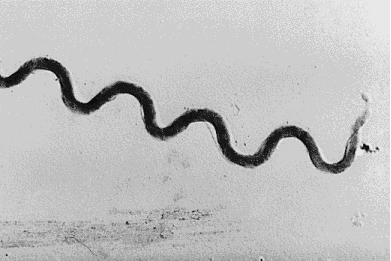
Syphilis (Treponema pallidum) |
| |
|
bacteria, end-hook allows for better attachment to host, found in tropical and temperate regions. Often in Kidey tubules. Transmission from urine of infected animal or enviroment |
|
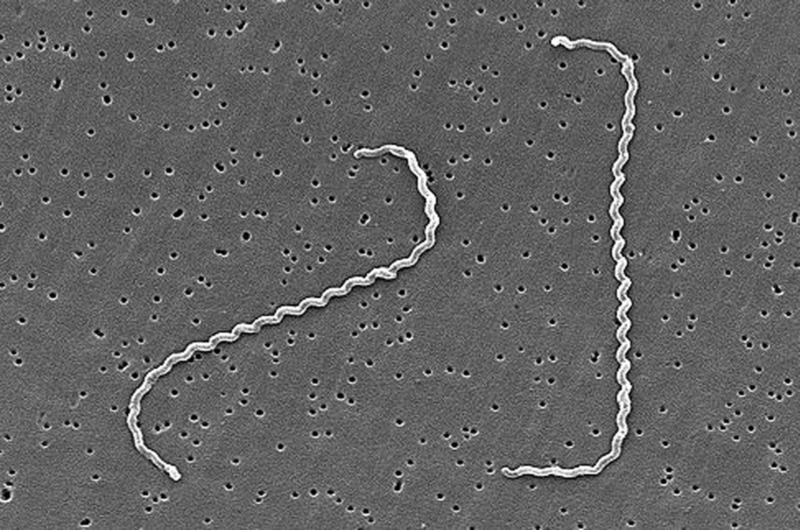
Leptospira interrogans |
| |
|
Tick born infection common in North America Red rash with consitutional symptoms chronic arthiritis and CNS effects |
|
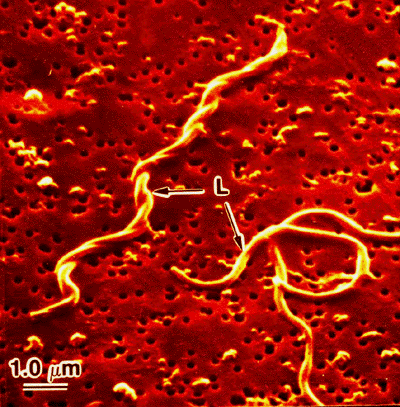
Borrelia burgdorfei |
| |
|
Ticks and lice used as vector for transmission. High fever (up to 43oC) for a couple days followed by hypotension and drop in temp. Peripheral blood smear with Gemsa or Wright staining to confirm diagnosis |
|
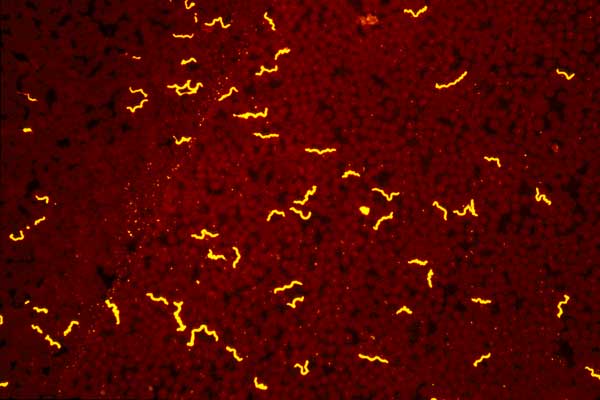
Relapsing Fever: Borrelia hermsii, Borrelia turicatae and Borrelia reccurentis) |
| |
|
Tropical areas of Africa, Asia, S. America. High lipid content Relies on host for fatty acids, nucleotides and amino acids. Direct person-to- person contact (through break in the skin); children under 15 more likelytobeaffected. 1o stage: lesion at inoculation site after 3 wk incubation 2o stage: widespread dissemination through blood results in multiple skin lesions Latentstage:symptomsusuallyabsent for up to 5 y; relapse may occur
3o: bone, joint and soft tissue lesions and deformities may occur |
|
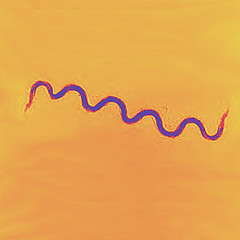
5 – Yaws (Treponema pallidum pertenue) |
| |
|
Food poisoning/intoxication, toxin mediated skin syndrome. Hospital acquired infection. oFten resistant to many antibiotics. Typically infects wounds or catherters. Many people are carriers. Coagulase +ve Gram +ve, coccus. |
|
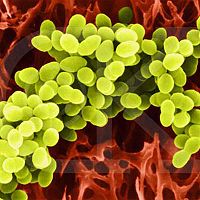
Staphylococcus aureus |
| |
|
Coagulase -ve, gram +ve coccus. Opportunistic infection often found in blood. Part of the normal flora of skin. Forms biofilms on plastic. Can cause endocarditis peritonitis bacterimia |
|
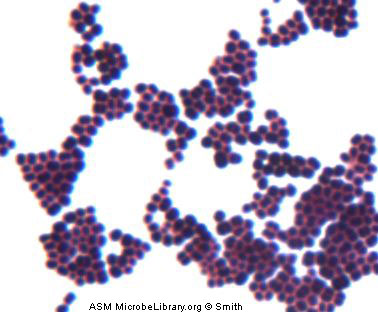
Staphylococcus epidermis |
| |
|
Normal GI flora, coagluase -ve gram +ve coccus. 2nd most common UTI in females. Surface adherens facilitate attachment |
|
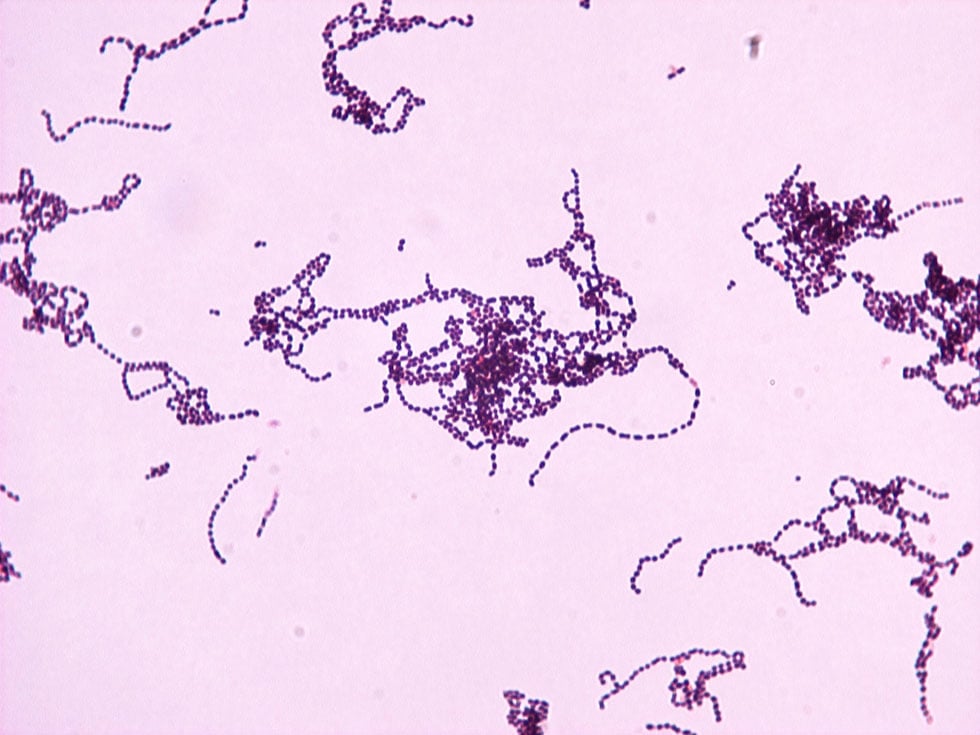
Staphylococcus saprophyticus |
| |
|
coagluase -ve gram +ve coccus part of normal skin flora can cause skin or soft tissue infections as well as endocarditis |
|
Staphylococcus lungdunensis |
| |
|
coagluase -ve gram +ve coccus part of normal skin flora can cause skin or soft tissue infections as well as wound infections |
|
Staphylococcus haemolyticus |
| |
|
Scarlet Fever, pharyngitis necrotizing fascitites rheumatic fever. Direct person to person transmission. |
|
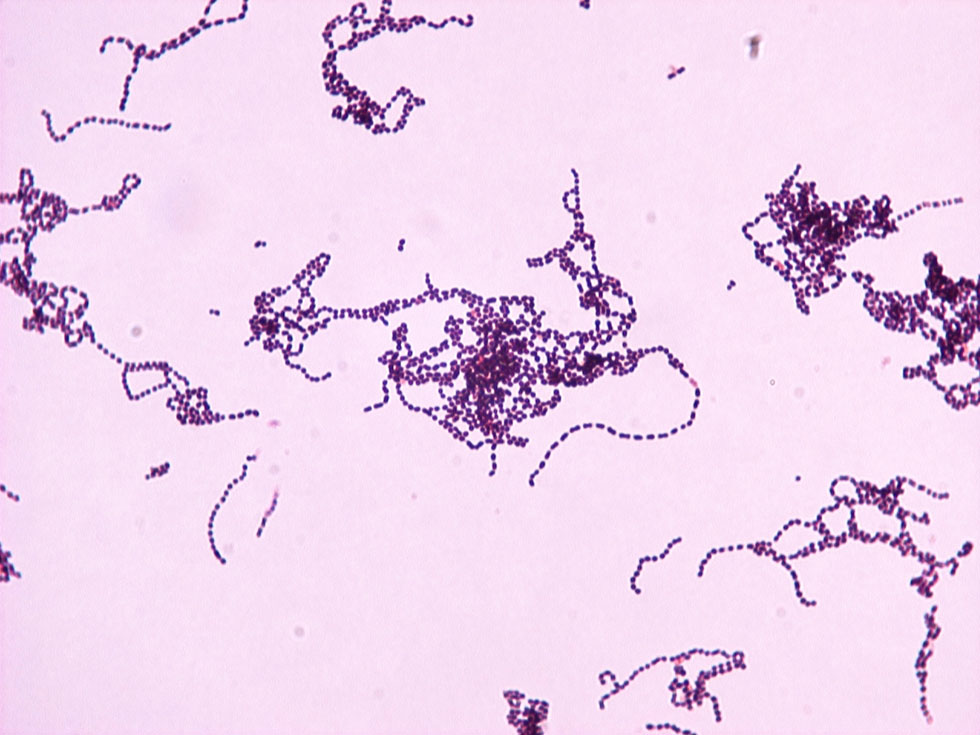
Streptococcus pyogenes |
| |
|
Gram +ve bacteria belonging to the lactic acid bacteria group. Coccus Neonates pheumonia sepsis and meningtis. Droplet transmission |
|
Streptococcus agalactiae |
| |
|
Gram +ve bacteria belonging to the lactic acid bacteria group. Pneumonia Meningitis and Otitis media. droplet transmission. |
|
Streptococcus pneumonia |
| |
|
Font Size... Font Family...
Gram -ve bacillus Aerobic. Commensal bacteria in large intestine motile with peritrichous flagellae. Fecal-oral transmission. Causes Gastroenteritisi and heat stable/labile enterotoxin which prvents water absorption in intestinal cells. Causes 90% of UTIs. Causes neonatal menintisis |
|
Escherichia coli |
| |
|
Gram -ve facultative anaerobe. transmitted in contaminated food or water. produces diarrhoea abdomonal pain and fever. Infects small bowel and proximal large bowel. Can invade to the basolateral side and replciate within macrophages and avoid innate immune response and form granulomas and microabcesses |
|
Yersinia enterocolitica |
| |
|
Gram -ve non-motile ferments glucose but not lactose. transmitted person to person (fecal-oral) Causes watery and possibly bloody stool. Uses an actin tail to spread |
|
Shigella |
| |
|
Gram -ve casues diarrhea fever vomiting and abdominal cramps. Fecal-oral transmission from contaminated foods. Avoids destruction in stomach and colonizes ileum and cecum with flagellum and pili. |
|
Salmonella enterica |
| |
|
Black Death. Gram -ve non-motile. Transmitted from rodent fleas handling infected bodies or bites from infected cats or rodents. dever chills headache death in 90% of patients. travels to lymph node and multiples to form buboes |
|
Yersinia pestis |
| |
|
gram -ve cocci motile contains pili. Transmitted sexually. attaches and penetrates mucosal cell surface with local proliferation. Women asymptomatic purulent discharge from genitals especially in males. burning senstation wehn urinating |
|
Neisseria gonorrhoea |
| |
|
gram negative diplococci. respiratory route through aerosoloized perticles. Meningtitis neck stiffness and altered mental status (manic behaviour) sudden onset of fever nausea vomiting headache and mygalia |
|
Neisseria meningitidis |
| |
|
gram -ve cocco bacillus obligate aerobic transmitted by respiratory route. Contains a toxin which stops cilia from beating and toxins that block macrophage. 5+ coughs at a time followed by high pitched whooping sounds. runny nose sneezing loq grade swab |
|
Bordetella pertussis |
| |
|
gram negative coccobaccillus. Sexually transmitted enters skin through break in epithelial cells. Women sometimes asymptomatic casues painful erythematous paules that can burst and cause ulcers |
|
Haemophilus ducreyi |
| |
|
gram -ve rod facultative anaerobe non- motile. transmitted through respiratory route in aerosol droplets. LPS can cause inflammatory response. Capsule prevents phagocytosis and IgA protease. meningtitis bacteremia lethargy and vommiting |
|
Haemophilus influenza |
| |
|
gram -ve with curved rod shape and polar flagella. Facultative anaerobes. Transmitted by consumption of fecal contaminated drinking water. pilli used to colonie small intestine. Secretes ____ toxin activates G protein causing high cAMP and CFTR activation and efflux of ions and water from infected cells. Severe dehydrating diarrhea death rate 25-50% in untreated patients. |
|
Virbio Cholerae O1 (epidemic potential) |
| |
|
gram -ve with curved rod shape and polar flagella. Facultative anaerobes. Transmitted mainly through contaminated food same as O1 but usually not fatal |
|
Virbio Cholerae non-O1 (No epidemic potential) |
| |
|
gram -ve with curved rod shape and polar flagella. Facultative anaerobes. Acquired when swimming with open wounds in infected water or after eating undercooked seafood. Releases capsular polysaccharide that triggers TNF alpha. Rapidly expanding cellulitis if wound infected. Vomitting diarrgea if food borne |
|
Vibrio vulnifcus |
| |
|
gram -ve with curved rod shape and polar flagella. Facultative anaerobes. Acquired from undercooked shellfish or through conumption of cecal contaminated drinking water/food. Mild to moderate gastroenteritis casuing diarrhea abdomnia |
|
Vibrio parahaemolyticus |
| |
|
Gram -ve obligate intracellular bacteria non-motile non-spore forming aerobes highly pathogenic transmitted by ticks and fleas. Occurs in Americas. Ticks must bite for several hours. Headache fever muscle pain nausea vomiting rash on soles and palms of feet black spot in middle of rase where bite occured. |
|
Rocky Mountain spotted fever. Rickettsia rickettsii |
| |
|
Gram -ve obligate intracellular bacteria non-motile non-spore forming aerobes highly pathogenic. Transmitted by feces of human body louse that enters via cut or skin abrasion. Occurs in regions of crowded ciold unhygionic locations. Severe fever headache pain nausea diarrchea. macular flot rash from trunk to extremities. SOme patients have confusion or seizures. |
|
Rickettsia prowazekii (Epidemic Typhus |
| |
|
Gram -ve obligate intracellular bacteria non-motile non-spore forming aerobes highly pathogenic. transmitted by mites that live on house mice. occurs in urman areas. disease is mild and self limited. Skin lesion wherre bite occured abrupt onset of fever and constittutional symptoms papulovesicular rash |
|
Rickettsia akari (Rickettsialpox) |
| |
|
Gram -ve spiral bacterium with flagella. Transmission fecal-oral. Urease creates ammonia for protection from stomach acid. Adhesion to gastric epithelium. Increased vulnerability to acid damage. |
|
Helicobacter pylori |
| |
|
Gram -ve spiral bacterium with flagella. Transmitted by contaminated meat (poultry) and water. Leading cause of acute enteritis worlwide. High fever headache malaise abdominal cramps watera diarrhea . Can trigge Guilliain Barre syndrome |
|
Camplylobacter jejuni |
| |
|
ssRNA virus icosahedral non-enveloped. Leading cause of viral gastroenteritis in developed nations. Blunts jejunal villi binds to human hiso-blood group antigens. Vomiting diarrha. Non inflammatory diarrhea (loose or watery) fecal oral transmission |
|
Norovirus |
| |
|
dsRNA virus. Icosahedral non-enveloped. fecal oral transmission. Lysis of jejunum epithelial cells. Diarrhea NSP4 increases chlorine secretion. Watery diarhea |
|
Rotavirus |
| |
|
Acid fast staining thick hydrophobic cell wall Primary infection: transmission by inhlatation of droplets often asymptomatic. Engulfement by macrophages resitance to phagolysis by baccili. Granuoma with viable bacteria inside. Latent infection of variable length then reactivation of TB with dissseminated infection and multiple lung |
|
Mycobacterium tuberculosis |
| |
|
Acid fast staining thick hydrophobic cell wall. environmentally acquired Disseminated disease is an AIDS defining illness patients present iwth abdominal pain and diarrhea. Pulmonary disease in immunocompetent patients. cough sputum production. Cercical lymphadenttis: occurs in children 1-4 years with enlarged lymphnodes |
|
Mycobacterium avium complex (MAC) |
| |
|
Acid fast staining thick hydrophobic cell wall. Obligate intracellular pathogen. Transmitted bu close contact. anasthesis skin lesion and plasiases. three forms Tuberuloid, boderline lepromatous |
|
Mycobacterium leprae |
| |
|
Found in soil decarying vegtables and aquatic enviroments. Strong resistance normally. Risk factors are glucocorticoid therapy malignancy organ transplant and HIV. Gram positive acid fast filamentous branching rods |
|
Nocardia asteroides |
| |
|
Opportunistic infection that ofren infecrs the nose throat and oral cavity. Can also infect thoracic and abdominal regions. Can from a walled off absceess |
|
Acintomyces israelli |
| |
|
retrovirus with lipid envelope and viral glycoproteins linear single stranded RNA genome ADult T-cell leukemia tropical spastic |
|
HTLV-1 |
| |
|
retrovirus with lipid envelope and viral glycoproteins linear single stranded RNA genome
Hairy cell leukemia neurodegeneration
Viral RNA and proteins passed through virological synapse, suspected use of GLUT-1 transporter. No detectable viral particles; Cell-Cell ONLY |
|
HTLV-2 |
| |
|
retrovirus with lipid envelope and viral glycoproteins linear single stranded RNA genome Newly identified in Africa
specific disease unknown
Viral RNA and proteins passed through virological synapse, suspected use of GLUT-1 transporter. No detectable viral particles; Cell-Cell ONLY |
|
HTLV-3/4 |
| |
|
retrovirus with lipid envelope and viral glycoproteins linear single stranded RNA genome Tac-antigen negatvie cutaneous T
cell lymphoma-leukemia
Viral RNA and proteins passed through virological synapse, suspected use of GLUT-1 transporter. No detectable viral particles; Cell-Cell ONLY |
|
HTLV-5 |
| |
|
retrovirus with lipid envelope and viral glycoproteins linear single stranded RNA genome Lentivirus transmitted through sexual intercourse and transfusion products
Infects CD4 cells |
|
HIV-1 |
| |
|
retrovirus with lipid envelope and viral glycoproteins linear single stranded RNA genome Lentivirus transmitted through sexual intercourse and transfusion products
Infects CD4 cells. Less virulent version |
|
HIV-2 |
| |
|
Linear ssRNA virus non-enveloped lytic and small. Transmitted by aerosol droplets. Children are main reservoir. Accounts for 1/3 to 1/2 of common cold. |
|
Rhinovirus |
| |
|
ssRNA virus ~30kb (very large viral genome). Spherical with crown like glycoprotein spikes. transmitted by aerosol droplets and by fecal-oral. Affects upper and lower respiratory tracts and GI tracts. SARs affects lung early in disease. Can cause diarrhea in children. |
|
Coronavirus |
| |
|
SSRNA envoleped with helical nucleocapsid. Transmitted by contact with nasal secretions can survive for hours on hands and nosocomial spread is common. |
|
RSV |
| |
|
ssRNA, enveloped. transmitted by aerosol contaminated persons. Epidemics between Dec and May. Hemagglutan attachment and fusion in endosome. Neuraminidase: allows viral particles to be released. URT and LRT symptoms + systemic symptoms (fever headache myalgia weakness) |
|
Infleunza virus |
| |
|
Causes sores on mucous membranes in the mouth Neuroinvasive, in latent state resides in cell bodies of nerves |
|
HSV-1 |
| |
|
Causes sores on mucous membranes in the genital regions Neuroinvasive, in latent state resides in cell bodies of nerves
|
|
HSV-2 |
| |
|
Airborne highly contagious produces papular rash on head and neck. Can be reactivated with rash localized to a dermatome` |
|
Herpes varicella and herpes zoster (HHV- 3) |
| |
|
Infectious mononucleousis, burkitts lymphoma nasopharyngeal carcinoma. Transmitted through saliva blood transfussion and tissue transplants. Infects epithelial cells |
|
lymphocryptovirus HHV-4 (epstein Barr virus) |
| |
|
Acute glandular fever congenital microcephaly heptosplenomgaly. transmitted by body secretions (saliva urine, genital secretions) Infects URT Casuses giant cells. |
|
cytomegalovirus HHV5 |
| |
|
Transmitted by saliva respiratory secretions infects CD4 cells causes sudden fever in infeants followed by rash. Almost all people are have antobides by 2 years of age. harmless unless immunocomprimised |
|
HHV6, HHV7 rosolovirus |
| |
|
Karposi's sarcoma, transmitted sexular , saliva. States of immunocomprimise contribture to development. |
|
HHV-8 Karpso's sarcoma assocated herpes virus |
| |
|
Yeast, part of normal flora of oral cavity most common fungus that causes problems in humans GI tract and vagina. Can cause oral thrush esophagitis vaginitis cutaneous infections (diaper rash). Increased incidence in immunocomprimised patients. Opportunistic pathogen can occur following a course of antibiotics |
|
Candida albicans |
| |
|
Yeast found in soil and pigeon droppings transmitted by inhalation. Causes pulmonary central nervous system or disseminated disease. Occurs often in AIDS patients |
|
Cryptococcus neoformans |
| |
|
Dimorphic fungi, US, Canada, Africa, Asia Flu like illness 40% mortality in AIDS patients Broad based buds with double walls, get flu like symptoms can occur in cottage country dogs can get this as well |
|
Blastomyces dermatitidis |
| |
|
Valley fever Dimorphic fungi. Very infections, tires filled in arizona can contain spores that can infect
North/South America. Dry, alkaline soils. Inhalation of spores results in endosporulation and spherules. Granulomas formation in lungs can disseminate through blood. 60% asymptomatic, mild illness 1-4wks after exposure. Pulmonary symptoms, Fever, cough, SOB, night sweats. 5-8% become chronic. |
|
Coccidioides immitis |
| |
|
Cavers Disease Dimorphic fungi. Similar radiological findings as TB World-wide. Damp, acidic soils near bat/ bird droppings. Alveolar deposition of conidia/ mycolial fragments. Hematogenous dissemination to CNS, liver, spleen possible.5% of acute fibrinous granulomas, pericarditis and pleural effusion. Chronic infection with underlying lung disease. |
|
Histoplasma capsulatum |
| |
|
Dimorphic fungi South/Central America. Aerosolized spores are inhaled and lodged in lungs and form primary pulmonary infection. Can infect Armadillos. Acute pneumonia possible progression to mucocutaneous necrotic lesions, lymphadenopathy or hematogenous dissemination. Infection rarely occurs in women due to female sex hormones |
|
Paracoccidioides
brasiliensis |
| |
|
Dimorphic fungi SouthEast Asia (Burma) Contact with Bamboo rats or the soil from their burrows. Inhalation of spores.Fever, weight loss, anemia, hepatosplenomegaly, lymphadenopathy. 80% in immunocompromised and AIDS. Skin lesions |
|
Penicillium marfenii |
| |
|
Dimorphic fungi Rose-Gardeners Disease Dimorphic fungi US, South America. Soil/ garden plants. Cutaneous puncture by thorns/ splinters near infected soils. Possible zoonotic from lesions. Pustulas, ulcerated nodules 1-10wks after inoculation. Can result in pulmonary, osteoarticular (joint), or disseminated spread. |
|
Sporothrix schenckii |
| |
|
ProtozoaTransmitted by Tsete fly. Found in africa. Causes sleeping sickness (fever headacehes joints paints itching lymph node swelling urge to sleep during the day) |
|
Trypanosoma brucei |
| |
|
parts of latin america. - enter through infected feces of triatomine bug - multiply by binary fission inside cell - release into bloodstream -symptoms are caused by cell death and the accompanying inflammatory and repair responses.
can replicate in cells, but not blood. Chagas disease -
Acute phase: Most are asymptomatic, but children and immunocompromised may display non- specific symptoms: fever, diarrhea, , fatigue, body aches, headache, rash, loss of appetite, and Romana sign (swelling of tissue near site of entry) -Chronic phase: Irreversible GI, nervous system, and cardiac tissue damage |
|
Trypanosoma cruzi |
| |
|
Protozoa transmitted by sandfly occurs
worldwide except austrailia.
-leishmania grows and replicates in host macrophages - Infected macrophages can remain in skin and cause cutaneous Leishmaniasis or disseminate through reticuloendothelial system causing vascular Leishmaniasis
-Cutaneous Leishmaniasis results in dry or wet painless ulcers in the skin, which may resolve in a few months or persist for years -Visceral Leishmaniasis causes splenomegaly, anemia, cachexia, fever, death |
|
Leishmania |
| |
|
Protozoa transmitted by ticks occurs in
north eastern united states Tick takes a blood meal -> sporozites introduced into host -> trophozoite -> merozoite Tick stays in RBCs Asymptomatic (25% adults, 50% children) Malaria-like symptoms appear 1 to 8 weeks post tick-bite: malaise, fever, chills, sweats
Untreated: resolves in healthy individuals, but could get shock-like symptoms For immunocompromised, elderly or splenectomized, death within 5-8 days of symptom onset For fever or hemolytic anemia post blood transfusion, consider babesiosis |
|
Babesia microti or divergens |
| |
|
Protozoa transmitted by mosquitoes malaria: Transmitted by anopheles mosquitoes (only bite from dusk to dawn)
occurs mainly in africa. - parasite invades red blood cell and causes changes in cell membrane - RBC lysis, release of cellular contents, activation of inflammatory and immune responses
- Cytoadherence to cell surfaces hemolytic anemia and splenomegaly - non-specific flu-like symptoms: chills, fever, and headache - microvascular diseases ␣ renal, CNS - if left untreated, can develop into serious illness leading to death
Malaria |
|
Plasmodum falciparum |
| |
|
Giardia lamblia
|
|
Enteric protozoa Bever Fever |
| |
|
Cryptosporidium parvum, |
|
Enteric protozoa |
| |
|
Cyclospora cayetanensis
|
|
Enteric protozoa Traveler’s Diarrhea |
| |
|
Entamoeba histolytica |
|
Enteric protozoa |
| |
|
Serous Cavity: Mansonella perstans Lymphatic, Brugia malayi Brugia timori Get swelling of limbs and testicular hydrocoel Mosquito pick up microfilariae from blood; mature into larvae in 7-21 days -Larvae migrate to mosquito’s mouth and enter bloodstream with next bite Recurring infections – parasite may bring endosymbiotic pathogenic bacteria with it lephantiasis (5% of cases) – lymphedema = grossly swollen limbs, often irreversible -Testicular hydrocoele – swelling, which may turn into elephantiasis – 50% of males -Renal Impairment – when renal lymphatics are involved, can lose protein / fat in the urine (chyluria) which may lead to milky appearance and nutritional deficiency |
|
Filariasis
|
| |
|
-Larvae in water are ingested by copepods (water fleas) - Water fleas are ingested when humans drink the water -Larvae are released and migrate through intestinal wall into tissues -Larvae mature and mate in the peritoneal space or abdomen and mate, 60-90 days after infection -1 year after infection, females move to skin in lower extremities and cause intense pain cooling off in water allows females to discharge larvae Fever, itchy rash, nausea, vomiting, diarrhea, dizziness -When worm exits, secondary infection is very common -Abscess formation, cellulitis, and pain at exit site is also very common by Trebek - Use a stick to pull worm out little by little, Caduceus staff -Eliminated b -Sepsis, joint infections and/or tetanus can be dangerous complications -Adult worm can become encapsulated and calcified, causing chronic pain / inflammation -If worm breaks during removal, can cause even more pain and inflammation |
|
Dracunculiasis medinensis |
| |
|
Most people get this as children Airborne eggs from skin
Developed + developing countries Temperate and tropical Worm inhabits human small and large bowel, and deposits eggs in perianal skin Ectopic migration of worms
Perianal pruritis Bean-shaped eggs in sample (scotch tape test: place on anus and look for microscopic eggs) Mebendazole |
|
Pinworm Enterobius vermicularis |
| |
|
Induced to migrate in response to general anestetic (can block bile duct or come out of mouth/nose) Fecal-oral 1.7 B people infected globally Tropical Larvae hatch in small bowel, spread to lungs via blood, mature, reswallowed, adult worms in gut Pulmonary infiltrates, cough, dyspnea
Rare: billiary disease and pancreatitis Eggs or worms in stool sample, history, eosinophilia Mebendazole |
|
Ascariasis Ascaris lumbricoides |
| |
|
Fecal-oral Tropical and subtropical Worm inhabits human small and large bowel, embeds in mucosa, eggs passed in stool Rectal prolapse with edema
Finger nail clubbing
Anemia, malabsorption Eggs or worms in stool sample, history, eosinophilia
Bowel Prolapse in kids |
|
Whipworm Trichuris trichiura |
| |
|
Track on skin where the worm was, look for in old men on the trunk and War vets. Fecal-dermal via soil Tropical and subtropical Penetrate skin → circulation → lung → swallowed → mature in gut, penetrate mucosa → circulation Hyperinfection syndrome: disseminated disease associated with high mortality Local skin lesion with pruritis Ivermectin |
|
Threadworm Strongyloides stercoralis |
| |
|
Fecal-dermal via soil 576-740 M people infected globally Areas with damp soil Penetrate skin → circulation → lung → swallow → attach to mucosa → feed on blood no need to treat if not anemic Cough, dyspnea
Anemia, malnutrition, weight loss Local skin lesion with pruritis |
|
Hookworm Necator americanus |
| |
|
Intestinal human parasite Infected meat (pork and game) Embeds in intestinal mucosa, eggs form encapsulated cysts in muscle Fatigue, fever, muscle pain, headaches
Cardiac, pulmonary, CNS infiltration → severe complications History is sufficient in endemic area
Serology Muscle biopsy |
|
Trichinella |
| |
|
Gram -ve aerobe thin non-fermenting rod-like produces B-lactamase Water born transmission primarily inhaled aerosoles. Lives within alveolar macrophages resistant to degredation proliferates intracelluarily. Pneumonia can be severe |
|
Legionella pneumophilia |
| |
|
No cell well wall cholesterol membrane small genome due to gene reduction smallest self replicating life form obligate parasite. Person to person transmission via respiratory droplets. Walking pneuomonia with mile symptoms. Surface parasite attaches to cell via terminal organelle |
|
Mycoplasma pneumonia |
| |
|
gram -ve rod. biphasic life cycle elementary body reiculate body obligate intracellular energy parasite. Transmitted by aerosolized resporatory secretions. Causes pneuomnia bronchitis sinusitits laryngitis pharyngitis. EB is endocytosed by host cell prevents fusion of phagolysosome transforms into RB and then can go to one of two pathways (productive=EB to infect another cell, nonproductive = aberrant body resulting in persistent infection) |
|
Chylamydophila pneuomoniae |
| |
|
Anaerobic gram-positive rod, produces endospores. - spores are present in soil, dust, animal fecal matter. Enters through wounds in the skin - In the body, spores become bacteria and begin producing neurotoxic tetanospasmin that binds to receptors in the spinal cord and brain stem, blocking neurotransmission. - Symptoms begin 3 days-3 weeks after infection, and include lockjaw, neck stiffness, difficulty swallowing, and painful convulsions (opisthotonos), can break bones. Tennis racket morphology |
|
Clostridium tetani |
| |
|
Preformed toxins block acetylcholine release Anaerobic gram-positive rod, produces heat resistant spores. - found on the surface of fruits, vegetables and seafood, present in soil and marine sediment. - produces 8 types of toxins, can ingest preformed toxin, ingest spores that colonize GI tract and release toxin in vivo, wound infection, inhalation of aerolized toxin. - Toxin absorbed in GI tract and is resistant to human alimentary enzymes and gastric pH. - Toxin binds receptor on peripheral cholinergic synapses at ganglia and neuromuscular junctions (does not cross bbb), cytoplasmic disruption of acetylcholine release. - Acute onset bilateral cranial neuropathies associated with symmetric descending weakness, blurred vision, non specific gastrointestinal symptoms. |
|
Clostridium botulinum |
| |
|
Anaerobic gram-positive rod, produces spores. - Normal flora; also transmitted fecal-oral. Pathogenic strains produce toxin A and/or toxin B. Infections are associated with antibiotic use disrupting normal colonic flora. - Toxins cause changes in the cytoskeletal structure, causing cell retraction, apoptosis, and disruption of intracellular tight junctions. - Diarrhea with colitis: watery diarrhea 10 to 15 times daily with abdominal pain and low-grade fever. May present with pseudomembranes on colorectal mucosa. Can proceed to Fulminant colitis including severe pain, fever, abdominal distention. Complications include toxic megacolon (dilation of bowel with systemic toxicity) and bowel perforation. |
|
Clostridium difficile |
| |
|
Often involved in oral infections Anaerobic gram-negative rods - Large proportion of normal human flora (predominantly: B gut, P&P oral). - Infection via inoculated wounds, opportunistic infections: aerobes start primary tissue destruction, anaerobes become primary infection. - B: abscesses, intraabdominal sepsis, female genital tract infections not caused by STIs. - P&P: periodontitis and periodontal infections/abscess following gingivitis, deep neck space infection leading to potential airway obstruction. May cause aspiration pneumonia. |
|
Bacteroides |
| |
|
Anaerobic gram-positive cocci, part of normal human flora. - Can: become infectious when an individual is immunocompromised, occur in all body sites and work synergistically with other infections. - Variety of diseases based on site, common in the abscess of diabetes related foot ulcers. - Diagnosis via culture and presence of gas at the site of infection. - Treat with antibiotics (penicillin G), drain abscesses, expose infection to oxygen. |
|
Peptostreptococcus |
| |
|
Repetitive 45 degree branching Aerobic, saprotrophic fungi Commonly found in soil, decaying organic matter, and wet environments (ie, basements) Airborne through inhalation of conidia (spores) - Location in lung depends on size of conidia (alveoli for small, URT for larger) colonization of pulmonary mucus secretions following allergic reaction. Common in cystic fibrosis and asthma patients. Pulmonary ______ colonization of pulmonary mucus secretions following allergic reaction. Common in cystic fibrosis and asthma patients. Invasive ______ invasion of vessels and hematogenous spread. Bone marrow transplant patients and leukemia patients at highest risk. |
|
Aspergillus |
| |
|
Uncommon but it represents a serious infection that can progress quickly -Live in soil or on decaying matter -hyphae: variable sizes, asceptate, ribbon like appearance
-grow rapidly and produce airborne spores -inhaled airborne spores deposit in pulmonary alveoli (pulmonary zygomycosis) or nasal turbinates (rhinocerebral zygomycosis) -cutaneous infection possible (assoc. with trauma) - Opportunistic: increased risk in immunocompromised, poorly controlled diabetes, and iron overload patients.
- Infection often begins in alveoli or nasal turbinates; may extend contiguously. - Angioinvasion, hematogenous dissemination common. |
|
Mucorales |
| |
|
Jock itch, atheletes foot and increased incidence between 4th and 5th toe Ring Worm Trauma, poor hygiene (wet & warm). From person, animal, soil or shed cells (>1 yr. Invades stratum corneum à inflammation. Feed on keratin, only in hair, nails and skin. |
|
Dermatophytes |
| |
|
Fasciola hepatica 180 mill at risk worldwide• Eggs in watersnailreleased to aquatic vegetationingestedthrough duodenum wall and liver (5-6 weeks) to biliary ducts•Diagnosis history, symptoms, eggs in stool • Acute fascioliasis (hepatitis, peritonitis, death), invasive phase (fever, hepatomegaly, wasting, urticaria, eosinophia), Chronic hepatitis, cholangitis, pancreatitis |
|
Trematodes (flatworm)
(liver fluke) |
| |
|
Most common cause of hemoptysis in the world Transmission - undercooked crab. Epidemiology-22m. worldwide (mostly East Asia). Pathology- ingested then penetrate intestinal wall and become encapsulated in lungs. Disease In Humans - Paragonimiasis- Acute -diarrhea, abdominal pain, fever, cough, urticaria, hepatosplenomegaly, pulmonary abnormalities, and eosinophilia - Chronic-similar to tuberculosis. Diagnosis - Eggs in stool/Antigen detection/ Biopsy. |
|
Paragonimus westermani (lung fluke) Trematodes (flatworm) |
| |
|
Humans acquire infection by contacting fresh water with larvae from snails which presents as swimmers itch. Adult worms release eggs which can invade local tissue and cause a hypersensitivity reaction (Katauyama fever) 2-8 weeks after exposure. Diagnosis in stools. The adult female worm resides within the adult male worm's gynaecophoric canal, which is a modification of the ventral surface of the male forming a groove. The paired worms move against the flow of blood to their final niche in the mesenteric circulation where they begin egg production (>32 days) |
|
Schistosoma mansoni (Blood Fluke) Flatworm |
| |
|
Fasciolopsis buski Giant intestinal fluke. Up to 7.5cm in length. Inhibits upper regions of small intestine. Eggs discharged in stool, miracidia inhabits snail of Segmentia and Hippeutis species, then adheres to vegetation to be consumed by final host (human). Cause chronic diarrhea, anemia, ascites, toxemia, allergic responses. Diagnosis depends on stool microscopy |
|
(Intestinal Fluke) Flatworm |
| |
|
Hymenopilis nana Transmission: Fecal-oral transmission (highly infective, and ingestion of flies infested with it. Epi: Warm countries. Most prevalent worldwide, but 4% in US Pathology: Grow in the bowel. Primarily infects children. Mostly asymptomatic but at higher numbers cause abdominal pain, diarrhea, dizziness and irritability Diagnosis: stool sample exam for eggs. |
|
Cestodes (tapeworm, have proglottids)
(Dwarf Tapeworm) |
| |
|
Echinococcus multilocularis Transmission: Oral through eggs in food, definitive host is foxes, intermediate is rats. Epi: Worldwide distribution, from 0-15% in different areas. Pathology: Behaves like malignancy which invades, destroys tissue and can metastasize. |
|
Cestodes (tapeworm, have proglottids) |
| |
|
Cestodes (tape worm) Pork -non motile doesnt need to climb out of pork poop. |
|
Taenia solium (Pork Tapeworm); |
| |
|
Tapeworm: Fish Cestodes (has proglottids) From eating undercooked fresh water fish that have ingested water fleas contaminated with pathogen. Causes B12 deficiency and megaloblastic anemia. |
|
Diphyllobothrium lattum |
| |
|
Cestodes (tape worm) Beef motile needs to climb out of cow poop. Can also climb out of butt. |
|
Taenia saginta |
| |
